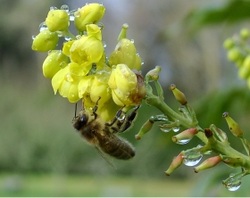The Bees

The Cornish Black Bee has come under increasing pressure over the last century. Various diseases decimated the number of colonies native to this beautiful part of the world. It became common practice to import the more prolific Italian bee, favoured due to it's increased honey yields.
In the last 20 years, the few remaining native black bee colonies have been further reduced by the importation of the varroa mite, along with yet more diseases.
However, some colonies still display the traits of the black bee. We have focussed our efforts on breeding from these colonies. It seems obvious that a native bee is better suited to the climate and environment it initially favoured.
The Black Bee can fly in poor conditions. It's dark colour and increased body hair enable it to fly in cold temperatures. They are also comfortable flying in the famous Cornish "Mizzle". By flying in poor conditions, the native bee is not confined to the hive for long periods of time and thereby seems to fair better against certain diseases, such as nosema. (The photo above was taken in January at 7 degrees C!).
The native bee is also an expert at resource management, having evolved along with the vagaries of the Cornish weather. If a colony determines that it has less than 20 pounds of honey, then it will reduce the laying rate of the queen according to the conditions. This bee also maintains a smaller population than a strain such as the Italian bee, enabling it to survive long periods of inclement weather.
At the Cornish Black Bee Company, we believe the advantages of working with native black bees far outweigh the disadvantages. In addition to having healthier, happier bees, we also minimise the risks of importing yet more pests and diseases by rearing our own Cornish bees.
In the last 20 years, the few remaining native black bee colonies have been further reduced by the importation of the varroa mite, along with yet more diseases.
However, some colonies still display the traits of the black bee. We have focussed our efforts on breeding from these colonies. It seems obvious that a native bee is better suited to the climate and environment it initially favoured.
The Black Bee can fly in poor conditions. It's dark colour and increased body hair enable it to fly in cold temperatures. They are also comfortable flying in the famous Cornish "Mizzle". By flying in poor conditions, the native bee is not confined to the hive for long periods of time and thereby seems to fair better against certain diseases, such as nosema. (The photo above was taken in January at 7 degrees C!).
The native bee is also an expert at resource management, having evolved along with the vagaries of the Cornish weather. If a colony determines that it has less than 20 pounds of honey, then it will reduce the laying rate of the queen according to the conditions. This bee also maintains a smaller population than a strain such as the Italian bee, enabling it to survive long periods of inclement weather.
At the Cornish Black Bee Company, we believe the advantages of working with native black bees far outweigh the disadvantages. In addition to having healthier, happier bees, we also minimise the risks of importing yet more pests and diseases by rearing our own Cornish bees.

